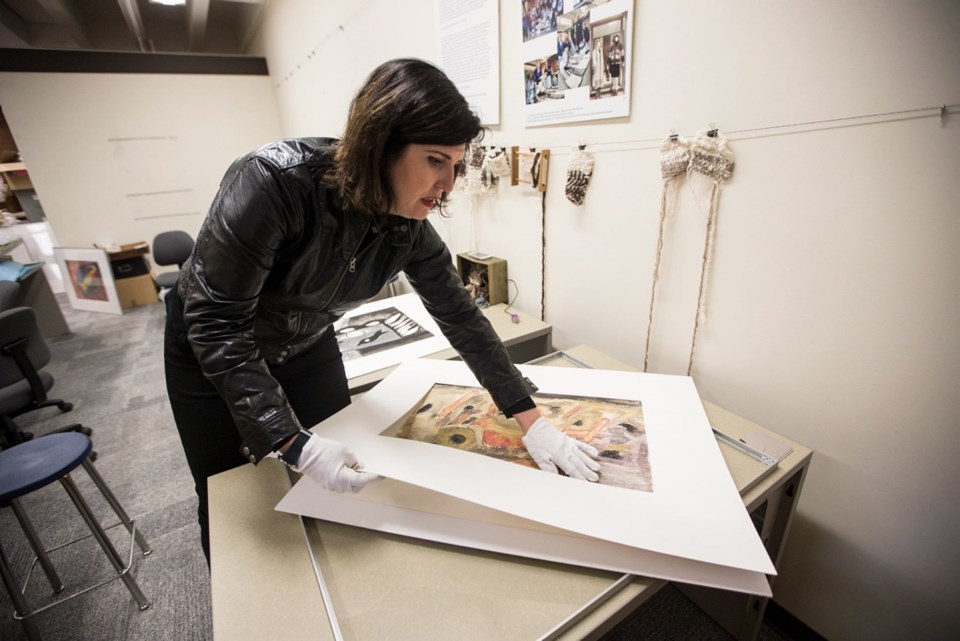While encountering children’s artwork from a Port Alberni residential school, University of Victoria anthropologist Andrea Walsh met one truth she couldn’t reconcile.
It was two paintings whose images and colours were so dark in spirit that Walsh’s instincts as a mother of two daughters went on alert. Only children working through something frightening could have created them.
Subsequently, instructions from the artists — now grown up — were for UVic to keep them, but lock them away and allow nobody to see them again. As custodians of the artwork, Walsh explained, the university was duty-bound to respect those instructions.
It was the one disturbing moment in an otherwise wondrous discovery of childhood artwork created by kids, age seven to 14, in the late 1950s and early 1960s at the residential school at Port Alberni. Most of the 75 paintings depict things such as catching fish in nets, eagles, ravens and scenes of the beach.
Children created them all after school in a special class conducted by an art teacher, who instructed pupils to paint their memories. When the teacher died, the paintings were discovered and passed to UVic in 2010, where Walsh found they were signed and began tracking down the artists.
Most of those adults loaned the works to UVic, where they are now part of a truth and reconciliation process. Digital images of a few will find a home at the Canadian Museum of History in Ottawa.
For Walsh, the paintings tell a truth that is elemental, a human connection with a real child making brush strokes on paper at a real moment. It allows viewers to connect with that person, during childhood, away from politics, statistics or commissions. As with any work of art, all a viewer has to do is look and engage.
“They [the paintings] give a voice to the child at the moment they were in the school, and it’s not through the lens of a contemporary politician or a revisioning of history,” she said.
“On that day, at that particular moment that child thought: ‘I want to be on a fishing boat,’ and painted that,” said Walsh.
Insights gained from those paintings, from working with the adults those child artists became and their surviving families have helped propel the university anthropologist into a new appreciation of the reconciliation process. She hopes to discuss it at an Ideafest event, Reconciliation and Resurgence: How Indigenous Artists Are Re-Imagining the History of sa���ʴ�ý.
Along with Walsh will be artists Carey Newman, creator of the Witness Blanket, a visual work inspired by residential school history, and Rande Cook, Audain chair and teacher at UVic. The discussion with be guided by broadcast journalist and UVic chancellor Shelagh Rogers.
Cook, a Kwakwakawakw artist from Alert Bay, said through listening to his grandfathers and other elders, he has come to see his people, like all people, in terms of relationships.
For his own people, Cook sees their single most enduring relationship is the one they have with the land they occupy. European colonization might have disrupted that relationship, but never snuffed it out. First Nations people are looking to how they can maintain that relationship in a modern sa���ʴ�ý.
But other relationships of First Nations people have also suffered from colonization. Residential schools battered the equality of the relationships between men and women.
Cook believes the government-driven process of colonization twisted the relationships between European newcomers and First Nations people. Initially built on human elements such as kindness and trust, those relations became strained by the pressure of governments and corporate entities such as the Hudson’s Bay Co., which were always pushing for more resources and more land.
Cook, like Walsh, now sees truth and reconciliation as an ongoing process, a continuous dialogue where the energy created by respect, warmth and community is always being renewed and refreshed.
“I’m always an optimist,” said Cook. “I love our country and I love its cultural diversity.”
“My goal is to allow people to be comfortable and understand who we are as First Nations,” he said.
“On a human level do I want to get to know other people? Yes. Do I want to build relationships? Yes. Do I want to laugh and celebrate sa���ʴ�ý with all my friends of all backgrounds? Yes,” said Cook.
Reconciliation and Resurgence: How Indigenous Artists Are Re-Imagining the Story of sa���ʴ�ý is on Tuesday, March, 7, 7-9 p.m. at Alix Goolden Hall, 907 Pandora Ave. Space is limited and registration is required — visit uvic.ca/ideafest.



